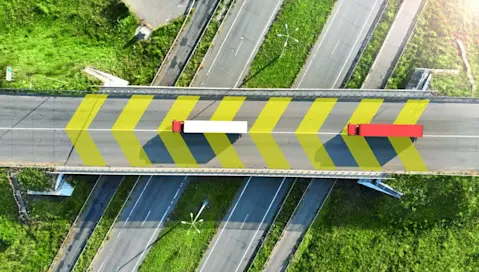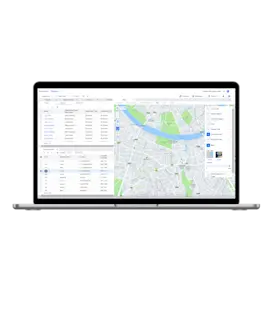Uitgelicht in deze blog
Route Planning Software 101: What Is It? And Why Do All Fleet Operators Need It?
Route Planning Software 101: What Is It? And Why Do All Fleet Operators Need It?
30 Jun 2021
Jim Endres
Customer experience has replaced product and price as the number one way brands differentiate themselves. CEOs now see customers as their biggest investment priority. For businesses whose service is judged largely on their distribution capabilities, excellence in delivery has become a critical element of improving this customer experience.
As a result, fleet managers who once operated in the shadows are now center stage in the battle for delivery excellence—in both B2C and B2B companies.
Yet many businesses continue to manage their fleets using rudimentary delivery route planning systems, or even manual methods, even though tools to automate route planning have been around for decades.
The attachment to old-school route planning methods is arguably most prevalent among small-to-midsize businesses with 20 to 150 trucks in the fleet. Still, many larger companies also rely on out-of-date software and systems. That’s despite the fact that the average ROI on route planning software, no matter the size of the fleet, is 3–12 months.
So, if your distribution or retail business is still using manual methods or a system that doesn’t position you for success, it’s time to rethink your strategy.
This guide provides everything you need to know about route planning software—from its function to the benefits you can expect.
Let’s start with the basics.
What Is Route Planning Software?
Route planning software helps businesses plan and schedule multi-stop delivery routes in the most efficient way possible using sophisticated algorithms. Some also call it routing and scheduling software or route optimization software.
When considering all the necessary variables and the number of possible permutations, it’s no surprise that software-aided route plans are far more accurate than manually planned routes. Meaning you can reliably deliver goods to customers exactly when you say you will—creating happier customers. When you do that day after day for months and years, you earn those customers’ loyalty and repeat business. That’s not something to be taken lightly.
But the primary reason most companies initially invest in delivery route planning software is to save money. Typically, automating route planning cuts 10-30% off your overall fleet operating costs by reducing the time and miles required to complete all deliveries. Every unnecessary mile you run costs you $2.80, based on the cost-per-truck-mile data from the National Private Truck Council.
Even for a small fleet of 20 trucks, each running 70,000 miles a year, a 20% reduction in fleet miles equates to $280,000. Many of our larger customers point to million-dollar-plus savings in the first year and beyond. And all of these cost savings drop straight to the bottom line.
How Does Truck Route Planning Software Work?
Many factors can affect which trucks get assigned to which routes and which drivers, and how long deliveries will take.
These factors include data from your operation, such as:
Delivery points
Driver and vehicle availability
Truck type and capacity
Customer-requested delivery times
As well as available data from outside of your organization, including:
Average road speeds at different times of the day
Low bridges
Road restrictions
The lists go on. And the combination of these factors results in millions of possible permutations.
As impressive as they are, human brains simply can’t match the number-crunching ability of clever software and a powerful computer. With delivery route planning software, orders are loaded into the system. Then sophisticated algorithms parse through all the factors to create routes that meet agreed customer requirements using the least amount of time and miles. The software does in minutes what even the most brilliant transportation planner couldn’t do, even in hours.
Basic software or manual methods such as Excel spreadsheets take too long and fail to consider critical factors that impact the routes. What does that mean for you? It means your fleet runs further than necessary. It means you have to add trucks and drivers to handle these unnecessary and costly miles. It means you cannot reliably provide precise delivery times for your customers.
The old way is the wrong way.
How Do You Know You Need Delivery Route Planning Software?
Multiple signs can trigger the realization you need to implement an advanced route planning system. Here are some of the main ones:
Crucial data is not centralized. There’s a wide array of data that makes routes accurate and efficient. If that information is not making it into a single software system, it’s staying exclusively in the heads of route planners. That’s a huge risk—if they leave or call in sick, that crucial knowledge is not available.
You can’t break down costs. Another sign you need this technology is if you don’t have visibility of data and methodologies across the organization. Without it, there’s no way to answer questions from the boss like, “Why are our fleet costs 15% higher here than our other locations?” But with route planning software, you can respond in minutes with a detailed breakdown.
You’re struggling to keep transportation costs in line with growth. Extra business means exponentially greater delivery complexity. Plans that once took three hours now take eight or 10 to construct. You’ll need the best tools possible to get that under control again and tame the labor costs.
If you simply can’t determine whether your fleet is efficient or not, you’re most likely ready for a system that can tell you quickly and constantly how you’re doing. Then it can help you identify those inefficiencies and fix them.
What Are the Benefits of Route Planning Software?
You save money. This bears repeating—the typical saving is 10-30% of fleet operating costs. Right off the bat and right off the bottom line.
You reduce planning time. Automated, optimized route planning reduces time to plan from hours to minutes. HAVI Taiwan, which distributes goods to fast-food and convenience chains in Taiwan, found that a team of planners spent up to 18 hours a day during peak seasons creating routes that met customer demands. Now, individual routes that took two hours to plan take 15 minutes or less. That frees staff up to solve more complex problems.
You improve customer service. Your delivery ETAs will be more accurate, which customers love. Route planning software can factor in any parameter to create feasible and efficient routes that include realistic schedules with precise arrival times. The result is a transportation plan that makes the best use of your available resources while meeting business KPIs and customer delivery requirements. After implementing automated route planning software, Colorado Boxed Beef achieved close to 100% customer satisfaction.
You keep your drivers happier. At a time when driver recruitment is difficult, implementing routing and scheduling software can increase driver confidence and satisfaction by showing an organizational commitment to rooting out inefficiencies. Route planning software also helps ensure work and pay equity across the driver pool, so junior drivers can be reassured that the deck isn’t stacked favorably for senior drivers. It also enhances driver safety by producing routes that avoid congested areas when possible, and ensuring vehicles are not routed on non-commercial roads or via weight-restricted bridges, among other obstacles.
You become more accountable. With better, quicker KPI reporting to share with your C-level executives, transportation looks more like a beacon of excellence and efficiency than just a cost center. Lean transportation teams tend to push reporting to the back burner as they scramble to get drivers out the door and manage ETA promises for hundreds of daily deliveries. But automated reporting from delivery routing software makes your operations transparent and accountable.
You can support game-changing strategic changes. Advanced route planning software has business modeling functionality that allows you to analyze hypothetical changes to your delivery network before making a single change. The software gives you the precise cost and service implications of, for instance, adding a significant new customer or changing the location of a distribution center (DC) or switching to smaller delivery trucks.
You can create a feedback loop for continuous improvement. Many fleet operators construct route plans but never systematically check whether drivers are actually following the plans. Route planning software lets you compare planned vs. actual routes in real time and then make adjustments as needed.
You can reduce or remove paperwork. One of the biggest benefits of electronic proof of delivery software is that lost or damaged paper delivery notes, time-consuming manual data entry steps and long delays in data processing become problems of the past. You can offer contactless delivery, too—something that’s increasingly in demand. You’ll also improve on site service, customer satisfaction levels and real-time visibility.
Do Benefits Extend Beyond Transportation?
The benefits of automated route planning software go far beyond the transportation department.
When you examine route planning data over time, it paints a clear picture of labor requirements for the distribution warehouse. That data can be used to create more efficient staffing plans that lower your biggest warehouse expense—labor.
Sales can use the software to conduct a cost to serve assessment to get the pricing right for new customers.
When trucks arrive on time and when software can enable proactive customer notification of delivery delays, you can eliminate up to 50% of “where is my order?” (WISMO) calls to customer service. At $7–$13 a call, that can decrease these costs dramatically.
Like a human body with multiple interdependent systems working together to form an overall state of health, the robustness of your business can be undermined by an underperforming part. Practically every department is reliant on the others, and that includes delivery route planning. That’s why it’s critical to get routing right. Right now.
And be warned. Failure to act in a timely fashion can mean the decision to introduce truck route planning software is made outside the transportation organization. That can occur when operations have gotten so out of control that fleet costs are rising faster than revenue, or customers are leaving due to unreliable service. That’s when C-level managers step in, and they might not have access to the expertise that will help them make the best choice. To avoid that scenario, you may need to take a step back and examine how the right technology can help you assess and fix inefficient delivery operations. And it’s best to do it before that call from the CEO.
What Are the Barriers to Automating Delivery Route Planning?
Transportation operations that move from manual or unsophisticated planning to advanced route optimization software can reduce transportation costs by 10–30% almost immediately. These gains come from a reduction in fleet size and driver force and decreased fuel and maintenance costs, to name a few. But if implementing this technology is such a no-brainer, why might you encounter resistance internally at your organization?
Old habits die hard. To put it plainly, the primary barrier is inertia. There’s comfort in “the way we’ve always done it”—particularly when people are busy with the day-to-day pressures of getting orders out the door.
Just because deliveries are achieved without constant glitches or angry customers, that doesn’t mean you don’t have a problem. In a busy operating environment, delivery route plans that are inefficient or otherwise problematic don’t tend to announce themselves—they lurk in the P&L sheet where it’s tough to root them out. Without route planning software, it’s possible for hundreds of thousands of dollars in profits to be leaking out without obvious warning signs.
Fear of automation. Some staff might see implementation of route planning software as a move toward automating their jobs out of existence. Quite the contrary is true. Our customers find, again and again, that the software is an incredibly useful tool when wielded by humans, and frees them up to do what humans do best—identify systemic problems and make strategic decisions that improve operations and customer satisfaction. Demonstrating to staff how the software will make their jobs easier and more rewarding will help overcome this resistance.
Cost of software/ROI. Nobody wants to propose spending money where there’s no clear business case. But it’s easy to demonstrate that the savings that kick in the moment you implement route planning software translate to a fast ROI—typically 3 to 12 months. Actual ROI results from Aptean Routing & Scheduling Paragon Edition customer implementations include Marigolds and Onions (3 months) and Glanbia (6 months). Further, the savings you gain are not one-and-done. Route planning software is the gift that keeps on giving.
In terms of selling the business case to internal stakeholders, a good technology partner will make it easier for you. Many route planning software providers offer to take sample data from your operations and model the impact of planning the same routes with the benefit of sophisticated routing technology. At no charge. After that, you may want to engage in a more detailed fleet analysis, including a live demo of what the software can specifically do for you. This will require a significant investment of time by your team and the routing experts at the software company. But the results could be eye-opening and game-changing.
Let Route Planning Software Take the Strain
Achieving delivery excellence is a challenge, and it’s only going to get more challenging.
Extra pressures are coming from changing customer demands—smaller, more frequent deliveries, expedited deliveries, tighter delivery time windows, and the desire for a more transparent delivery experience with visibility to in-progress routes and proactive alerts on delays.
Meanwhile, there are driver shortages, volatile fuel prices and increased restrictions on urban deliveries. Without advanced delivery route planning software, costs quickly escalate, and it’s nearly impossible to measure where the waste is.
That’s why businesses operating delivery fleets can no longer rely on old routing methods to compete with others who are constantly trimming costs and improving performance via this advanced technology.
If you’re not getting delivery route planning exactly right, you’re throwing money, customers and competitive advantage down the drain.
It’s time to invest in delivery route planning software.
So, if you’re ready to save money while improving customer satisfaction, then Aptean is ready to help. Reach out to one of our route planning experts to transform your transportation department and ensure your business is Ready for What’s Next, Now™.
Bent u klaar om uw bedrijf radicaal te veranderen?
We hebben gespecialiseerde TMS-oplossingen waarmee u elke uitdaging in uw branche aankunt.



